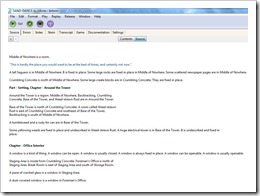This week I have spent most of my free-time in the evenings reading Aaron Reed’s ‘Creating Interactive Fiction with INFORM7.’ You only have to review Aaron’s online profile and contribution to INFORM6/7 to know that he had a real passion for his craft as well as looking beyond interaction fiction, “developing new forms of participatory storytelling” with Expressive Intelligence Studio at UC Santa Cruz.
So, where am I now. Having found the INFORM7 manual really challenging (I got as far as Chapter 3), I have moved on Aaron’s very useable book. Rather than endeavouring to be a how-to reference manual, the book invite readers to apply their knowledge by building optional parts of the Sand-dance, one of Aaron’s IF creations. I find that I am ‘learning’ INFORM7 with an experience guide on my shoulder. A guide that is also talking me through the importance of backdrops, rules, and of course, most importantly, narrative. In fact, Aaron’s book would undoubtedly make for an excellent course textbook (he comments, thinking ahead).
I am only 80/400 pages in, however I would strongly recommend that you read the book and explore INFORM7 at the same time. Originally, I started out just reading the book, however, having gone to a read-and-do approach I am find the conceptual nature of INFORM7 easier to get on with.
 I have already developed scenes and regions, added objects, assigned properties. I have learnt about supporters and containers, set rules, created ‘kinds’ and more, in fact I am confident that I have learnt more than enough to engage ALL levels of reading AND writing. Indeed, I am convinced that INFORM7 has immense value to education, to both literacy, ICT and all subjects that can not be physically created in lessons, particularly subjects like History for example.
I have already developed scenes and regions, added objects, assigned properties. I have learnt about supporters and containers, set rules, created ‘kinds’ and more, in fact I am confident that I have learnt more than enough to engage ALL levels of reading AND writing. Indeed, I am convinced that INFORM7 has immense value to education, to both literacy, ICT and all subjects that can not be physically created in lessons, particularly subjects like History for example.
Now, at the back of my thinking, I have this unnerving feeling that, like INFORM7, the my experience is about to digress and that the impact of programming will soon increase. Hold on, its going to be a bumpy ride for us non-coders. Of course, I could be wrong….
Meanwhile, in school I have been testing the waters with ‘threaded stories.’ My Year 7 class first planned their stories using sugar paper and marker pens before moving to Powerpoint to hyperlink their decision making narrative. It was certainly a very accessible starting point and the students clearly enjoyed the non-sequential writing style. This said, I am not sure that this level of student would be able to access INFORM7??
